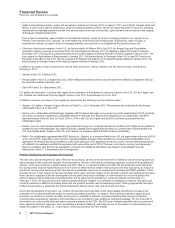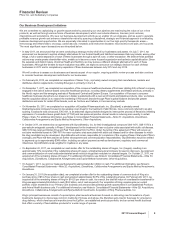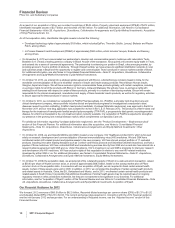Pfizer 2011 Annual Report Download - page 15
Download and view the complete annual report
Please find page 15 of the 2011 Pfizer annual report below. You can navigate through the pages in the report by either clicking on the pages listed below, or by using the keyword search tool below to find specific information within the annual report.
Financial Review
Pfizer Inc. and Subsidiary Companies
The market approach is only appropriate when the available external information is robust and deemed to be a reliable proxy for
the specific reporting unit being valued; however, these assessments may prove to be incomplete or inaccurate. Some of the
more significant estimates and assumptions inherent in this approach include: the selection of appropriate guideline companies
and transactions and the determination of applicable premiums and discounts based on any differences in ownership
percentages, ownership rights, business ownership forms or marketability between the reporting unit and the guideline companies
and transactions.
•The income approach is a forward-looking approach to estimating fair value and relies primarily on internal forecasts. Within the income
approach, the method that we use is the discounted cash flow method. We start with a forecast of all the expected net cash flows
associated with the reporting unit, which includes the application of a terminal value, and then we apply a reporting unit-specific
discount rate to arrive at a net present value amount. Some of the more significant estimates and assumptions inherent in this approach
include: the amount and timing of the projected net cash flows, which includes the expected impact of technological risk and
competitive, legal and/or regulatory forces on the projections, as well as the selection of a long-term growth rate; the discount rate,
which seeks to reflect the various risks inherent in the projected cash flows; and the tax rate, which seeks to incorporate the geographic
diversity of the projected cash flows.
Specifically, our 2011 goodwill impairment assessment involved the following:
•To estimate the fair value of our five biopharmaceutical reporting units, we relied solely on the income approach. We used the income
approach exclusively as many of our products are sold in multiple reporting units and as one reporting unit is geographic-based while
the others are product and/or customer-based. Further, the projected cash flows from a single product may reside in up to three
reporting units at different points in future years and the discounted cash flow method would reflect the movement of products among
reporting units. As such, the use of the comparable guideline company method was not practical or reliable. However, on a limited
basis and as deemed reasonable, we did attempt to corroborate our outcomes with the market approach. For the income approach, we
used the discounted cash flow method.
•To estimate the fair value of our Consumer Healthcare reporting unit, we used a combination of approaches and methods. We used the
income approach and the market approach, which were weighted equally in our analysis. We weighted them equally as we have equal
confidence in the appropriateness of the approaches for this reporting unit. For the income approach, we used the discounted cash flow
method and for the market approach, we used both the guideline public company method and the guideline transaction method, which
were weighted equally to arrive at our market approach value.
•To estimate the fair value of our Nutrition and Animal Health reporting units, we used the income approach, relying exclusively on the
discounted cash flow method. We relied exclusively on the income approach as the discounted cash flow method provides a more
reliable outlook of the business. However, on a limited basis and as deemed reasonable, we did attempt to corroborate our outcomes
with the market approach. (On July 7, 2011, we announced our decision to explore strategic alternatives for our Nutrition and Animal
Health businesses. See the “Our Business Development initiatives” section of this Financial Review.)
Future Impairment Risks
While all reporting units can confront events and circumstances that can lead to impairment, we do not believe that the risk of
goodwill impairment for any of our reporting units is significant at this time.
At the end of 2011, our Consumer Healthcare reporting unit has the smallest difference between fair value and book value.
However, we estimate that it would take a significant negative change in the undiscounted cash flows, the discount rate and/or the
market multiples in the consumer industry for the Consumer Healthcare reporting unit goodwill to be impaired. Our Consumer
Healthcare reporting unit performance and consumer healthcare industry market multiples are highly correlated with the overall
economy and our specific performance is also dependent on our and our competitors’ innovation and marketing effectiveness, and
on regulatory developments affecting claims, formulations and ingredients of our products.
For all of our reporting units, there are a number of future events and factors that may impact future results and that could potentially
have an impact on the outcome of subsequent goodwill impairment testing. For a list of these factors, see the “Forward-Looking
Information and Factors That May Affect Future Results” section of this Financial Review.
Pension and Postretirement Benefit Plans
The majority of our employees worldwide are covered by defined benefit pension plans, defined contribution plans or both. In the
U.S., we have both qualified and supplemental (non-qualified) defined benefit plans, as well as other postretirement benefit plans,
consisting primarily of healthcare and life insurance for retirees (see Notes to Consolidated Financial Statements—Note 1P. Pension
and Postretirement Benefit Plans and Note 11. Pension and Postretirement Benefit Plans and Defined Contribution Plans).
Beginning on January 1, 2011, for employees hired in the U.S. and Puerto Rico after December 31, 2010, we no longer offer a
defined benefit plan and, instead, offer an enhanced benefit under our defined contribution plan. In addition to the standard matching
contribution by the Company, the enhanced benefit provides an automatic Company contribution for such eligible employees based
on age and years of service.
The accounting for benefit plans is highly dependent on actuarial estimates, assumptions and calculations, which result from a
complex series of judgments about future events and uncertainties. For information about the risks associated with estimates and
assumptions, see Notes to Consolidated Financial Statements––Note 1C. Significant Accounting Policies: Estimates and
Assumptions. The assumptions and actuarial estimates required to estimate the employee benefit obligations for the defined benefit
and postretirement plans may include the discount rate; expected salary increases; certain employee-related factors, such as
14 2011 Financial Report
























